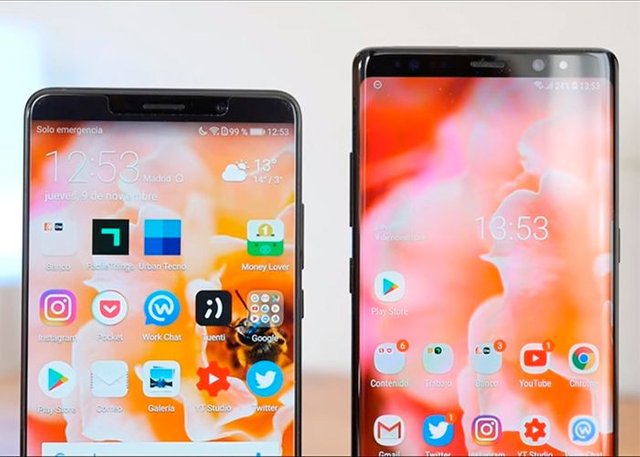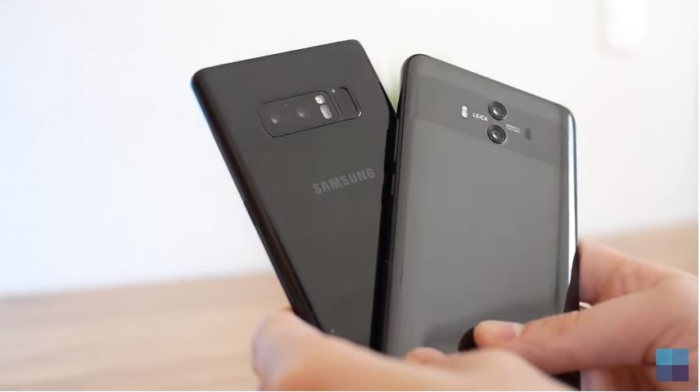Huawei Mate 10 vs Samsung Galaxy Note 8, comparative
The year 2017 is coming to an end, the important Christmas campaign is approaching, so do the CES fairs in Las Vegas - the first week of next year - and the Mobile World Congress in Barcelona - from February 26 to March 1, 2018 -, and it only remains to speak Honor and its V10 among the best smartphones of the Android platform nowadays.
Surely the young manufacturer Chinon is going to surprise us too much, and is that being a spin-off firm of the giant Huawei is most likely, in fact, that his most advanced device is the first cousin of a Huawei Mate 10 that competes at last directly with the Samsung Galaxy Note 8 for the lathe of the smartphone market, or at least for becoming the best Android of the year.
It does not do without merits, because Huawei advances ground with what is probably the best chipset for mobile devices that we can find in the market, a HiSilicon Kirin 970 that with its neuronal processing unit remains only in the field of machine learning and intelligence artificial, so the Huawei Mate 10 is surely the most prepared smartphone for the future that we can achieve today.

However, the Galaxy Note 8 can only say good things, and that the level of Samsung has reached very high levels. So much so that sometimes we wonder what will be next, where will improve these smartphones and almost as powerful as a desktop PC, but obviously there is a cryptonite: prices above 1,000 euros.
Koreans were already known more in this facet, and all they have done is take a step further to the acclaimed design of the Galaxy S8 +, which now accommodates less pronounced curvature to leave room for the S-Pen, removing 200 mAh step of capacity to your battery. Samsung's design is impeccable with the glue of the fingerprint reader, and its Note 8 is much higher and stylized to look at.
Of course, ergonomics and user experience are totally different things from one device to another, because although grabbing a Samsung that is narrower is more comfortable, reaching all parts of your screen with one hand is mission impossible. This in the Huawei is more bearable, although its width is felt penalizing the sensation in hand. Separate mention for the fingerprint reader, which Huawei manages to place on a front "all screen" and in the most optimal position.
In addition, the software also differs too much, with Samsung increasingly easing its TouchWiz personalization, now Samsung Experience, in favor of an increasingly pure Google experience; and Huawei for its part maintaining that EMUI 8.0 that the Chinese like, but in other markets it still squeaks with its interface more of the iOS style, although now it is true that we can finally introduce an application launcher and remove them from the desktops.
Little to comment on the hardware, and little to comment on power and performance. We will not discover America in a glass of water if we say that the fluidity and the experience of using one and the other are totally satisfactory, without the feared lags and without noticeable power failures.
And yet, again we find two conceptions, the Chinese and the Korean, which are totally different despite sharing a strategy: using the most possible self-made components.
As for Samsung screen wins, higher physical resolution offers better experience in virtual reality, and although many will say that does not improve the day to day and penalizes battery and performance, Koreans allow you to choose the logical resolution that will move the operating system, so not There is discussion.
Not only that, because the SuperAMOLED panels of the Samsung Galaxy Note 8 have gotten the best reviews from the experts in the market, getting deep blacks, very colorful colors, almost total viewing angles and an unparalleled visual experience. Huawei and its Mate 10 surely win in terms of targets, but the screen of Note 8 is probably the best on the market with permission from the iPhone.
The Kirin 970 is a chipset that thinks about the future, integrating a unit of neuronal processing that will improve the capabilities of the device in terms of artificial intelligence and machine learning, taking to the CPU in local operations that other manufacturers carry out in remote processing units. through the Internet. The Huawei Mate 10 thinks faster, and that is a plus that we should not ignore.

I look forward how's it going from now on!
Nice Article. I look forward to Mobile Week in February!
checkout latest Samsung Secret codes on my website.search "rehanhub" on google.